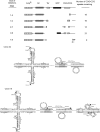Mutation spectra in fragile X syndrome induced by deletions of CGG*CCG repeats
- PMID: 18957433
- PMCID: PMC2658034
- DOI: 10.1074/jbc.R800024200
Mutation spectra in fragile X syndrome induced by deletions of CGG*CCG repeats
Abstract
The fragile X syndrome results from expansions as well as deletions of the repeating CGG.CCG DNA sequence in the 5'-untranslated region of the FMR1 gene on the X chromosome. The relative frequency of disease cases promoted by these two types of mutations cannot be ascertained at present because the routine clinical assay monitors only expansions. At least 30 articles have been reviewed that document the involvement of deletions of part or all of the CGG.CCG repeats along with varying extents of DNA flanking regions as well as very small mutations including single base pair changes. Studies of deletion mutants of CGG.CCG tracts in Escherichia coli plasmids revealed a similar spectrum of mutagenic products. The triplet repeat tract in a non-B conformation is the mutagen, not the sequence per se in the right-handed B helix. Hence, molecular investigations in a simple model organism may generate useful initial information toward therapeutic strategies for this disease.
Figures


Similar articles
-
Nucleosomal occupancy and CGG repeat expansion: a comparative analysis of triplet repeat region from mouse and human fragile X mental retardation gene 1.Chromosome Res. 2011 May;19(4):445-55. doi: 10.1007/s10577-011-9206-7. Epub 2011 Apr 16. Chromosome Res. 2011. PMID: 21499798
-
Establishment of FXS-A9 panel with a single human X chromosome from fragile X syndrome-associated individual.Exp Cell Res. 2021 Jan 15;398(2):112419. doi: 10.1016/j.yexcr.2020.112419. Epub 2020 Dec 6. Exp Cell Res. 2021. PMID: 33296661
-
AGG/CCT interruptions affect nucleosome formation and positioning of healthy-length CGG/CCG triplet repeats.BMC Biochem. 2013 Nov 22;14:33. doi: 10.1186/1471-2091-14-33. BMC Biochem. 2013. PMID: 24261641 Free PMC article.
-
The pathophysiology of fragile x syndrome.Annu Rev Genomics Hum Genet. 2007;8:109-29. doi: 10.1146/annurev.genom.8.080706.092249. Annu Rev Genomics Hum Genet. 2007. PMID: 17477822 Review.
-
Spontaneous rescue of a FMR1 repeat expansion and review of deletions in the FMR1 non-coding region.Eur J Med Genet. 2021 Aug;64(8):104244. doi: 10.1016/j.ejmg.2021.104244. Epub 2021 May 20. Eur J Med Genet. 2021. PMID: 34022415 Review.
Cited by
-
Beyond Trinucleotide Repeat Expansion in Fragile X Syndrome: Rare Coding and Noncoding Variants in FMR1 and Associated Phenotypes.Genes (Basel). 2021 Oct 22;12(11):1669. doi: 10.3390/genes12111669. Genes (Basel). 2021. PMID: 34828275 Free PMC article.
-
341 Repeats Is Not Enough for Methylation in a New Fragile X Mouse Model.eNeuro. 2022 Sep 12;9(5):ENEURO.0142-22.2022. doi: 10.1523/ENEURO.0142-22.2022. Print 2022 Sep-Oct. eNeuro. 2022. PMID: 35977823 Free PMC article.
-
Fragile X syndrome and fragile X-associated disorders.F1000Res. 2017 Dec 8;6:2112. doi: 10.12688/f1000research.11885.1. eCollection 2017. F1000Res. 2017. PMID: 29259781 Free PMC article. Review.
-
G-quadruplex nucleic acids and human disease.FEBS J. 2010 Sep;277(17):3470-88. doi: 10.1111/j.1742-4658.2010.07760.x. Epub 2010 Jul 29. FEBS J. 2010. PMID: 20670277 Free PMC article. Review.
-
Finding FMR1 mosaicism in Fragile X syndrome.Expert Rev Mol Diagn. 2016;16(4):501-7. doi: 10.1586/14737159.2016.1135739. Epub 2016 Feb 9. Expert Rev Mol Diagn. 2016. PMID: 26716517 Free PMC article.
References
-
- Wells, R. D., and Ashizawa, T. (eds) (2006) Genetic Instabilities and Neurological Diseases, 2nd Ed., Academic Press, San Diego, CA
-
- Orr, H. T., and Zoghbi, H. Y. (2007) Annu. Rev. Neurosci. 30 575–621 - PubMed
-
- Mirkin, S. M. (2006) Curr. Opin. Struct. Biol. 16 351–358 - PubMed
-
- Wang, G., and Vasquez, K. M. (2006) Mutat. Res./Fundam. Mol. Mech. Mutagen. 598 103–119 - PubMed
-
- Wang, Y. H. (2007) Front. Biosci. 12 4731–4741 - PubMed
Publication types
MeSH terms
Substances
Grants and funding
LinkOut - more resources
Full Text Sources
Medical

